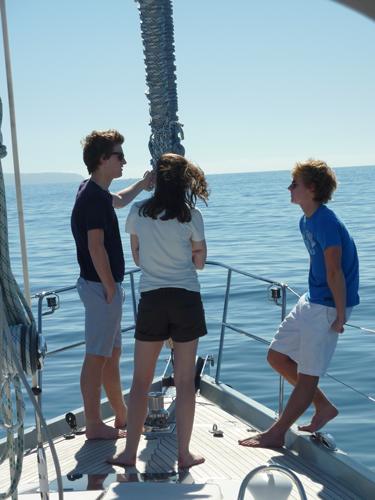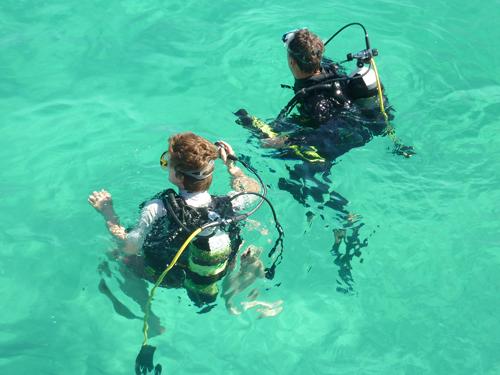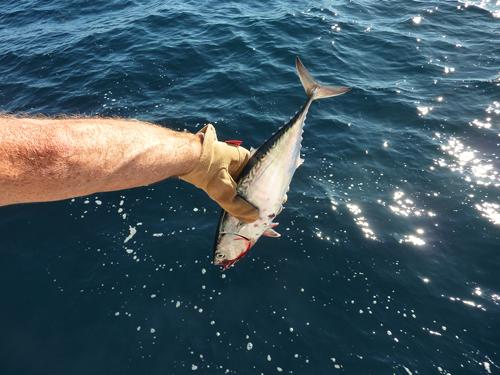Lists and more lists

39:34.04N 002:37.91E
A storm is brewing in the Golfe du Lion, casting a Transmontana wind deep into the southern Mediterranean. We leave our idyll at Cabrera and motor across to Playa Estrenc, a white sandy beach on the south east tip of Mallorca. The beach shelves gently into the ocean and the anchor drops into soft white sand a few hundred metres from the beach. We swim ashore and walk along the beach in the hot sun, squirming slightly at the sight of nudists parading with no apparent embarrassment as they discuss the price of fish.
We lunch on board and with the wind building from the south west, we decide to seek shelter for the night and sail back to the bay of Palma, making 9 knots as we reach along the coast with the wind on the beam. This is known as ‘champagne sailing’ because all yachts sail at their best when the wind is blowing at around 90 degrees on the beam, creating maximum drive. We overtake a motor yacht powering along burning gallons of diesel as we surge through the water with just the wind in our sails. After a night in the marina at Club Nautica Arenal we awake to find that the promised wind has arrived and we prepare to leave after breakfast. My concern is that the entrance to the marina is very shallow and as the wind drives the sea across the bay of Palma, the troughs in between the waves reduce the depth still further with the possibility of going aground with no escape route. We hurriedly prepare our dock lines and motor out of the marina. The echo sounder shows that we have only 40 centimetres (about the width of my laptop keyboard!) of water under our keel as we cross the bar and we hold our breath as the depth rises slowly , 0.4…0.5….0.6……0.9….2 metres and we are out. The bay of Palma is 10 miles across and with the wind blowing from the North West, big waves are piling up in the south east corner. This distance from the source of the waves is known as the ‘fetch’ and as we near our marina in Palma the fetch lessens and the sea calms in the lee of the shore. We dock in flat calm water with barely a hint of the wild weather raging to the East.
Sunday is maintenance day. Oyster equip every yacht with an embossed maintenance log which holds pages and pages of checklists which we are supposed to complete weekly, monthly, six monthly and annually. On handover of the yacht we are sternly instructed by Oyster to do our chores regularly and to send carbon copies of signed forms back to Oyster HQ as evidence of our diligence. These weekly checklists glare at me form the bookcase, daring me to ignore my responsibilities and I am conscious that it is three weeks since I last filled out the forms. Today I have to do the monthly checklist as well as the weekly one, and with each list the challenges become more and more demanding. Today I have to tick a box that asserts that I have tested the steering gear and adjusted the tension of the wire steering lines. Having no idea how to do this I grab Rory, the professional skipper on the Oyster 54 berthed next to us. We disappear into the big locker in the stern called the Lazarette and he shows me how to tighten the wire cables that snake from the steering wheels in the cockpit via a series of blocks and then encircle a large steel plate called the steering quadrant. This quadrant is attached to the yachts rudder post and provides the gearing that makes the steering so responsive even in a heavy seaway.
I work my way through the checklist, ticking off the chores as I go….. ‘check DC connection on bow thruster and windlass , clean sea water strainers and grease O rings, check attachments of all deck fittings, test electric and manual bilge pump, clean gauze strainers on fresh water pumps, replace the Racor filters’. These Racor filters are ingenious devices. They have an alarm which sounds if they detect any water in the fuel system and through a centrifugal device, any dirt and water in the fuel is ejected into a glass bowl that can be inspected and emptied. Clean fuel is the most important ingredient for a happy diesel engine and ours is smiling today; but I change the Racors regardless so that I can tick the final box and initial the checklist.
Tom
and Jamie fly out to Mallorca with a friend called Zoe and we spend a week
sailing in glorious autumn sunshine with temperatures in the high twenties.
Then it’s time to head back to the UK, so I clean the tender, put canvas covers
on all the winches and give the boat a good clean. Rory, our neighbour, is
going to keep an eye on Juno over the winter, providing a Guardinage service.
This involves cleaning the boat every two weeks, starting up all the systems,
running the engine and generator and generally keeping Juno ticking over. I will visit her every month over the winter
to do some of the bigger jobs with Rory, such as stripping down and lubricating
our 9 winches, taking the sails off for cleaning and then in March we will lift
her out of the water to repaint the antifoul on the hull and to check all the
skin fittings. We will also replace the many sacrificial anodes that are
attached to the hull to prevent electrolysis eroding our underwater steel
fittings. Electrical currents that leak into the harbour damage these
vulnerable parts of our boat, and to prevent this we attach anodes made of zinc
to various fittings on the hull; being made of a soft metal they attract the
current and erode, leaving our precious steel relatively untarnished.
Since we left Ipswich in early August we have packed in a wealth of new
experiences. The highs have been higher than those we normally experience in
our life at home and we have had some darker moments when we have questioned
whether we are really cut out for this existence. However, as the season has
worn on, we have become more at ease with our new life and more confident in
our ability to sail Juno by ourselves. Caroline in particular has become
visibly more self-assured and takes a greater interest in the technical aspects
of the boat. This increased self-confidence has also influenced her life ashore
and I watch her weaving her bicycle through the streets of Palma, seemingly
without a care in the world. I in turn, have found this simple way of life
deeply therapeutic and relaxing and as we end the season we are already
planning a longer voyage in the Spring. Our
plan for next year is to set off in April, heading East towards Sardinia,
Corsica and the Amalfi coast of Italy. Then sailing West again in the autumn to
reach the Canary Islands in time for the start of the ARC, our Atlantic
crossing in late November, arriving in the Caribbean in time for Christmas
2012. What an exciting prospect!





